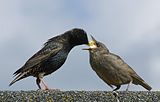- Durophagy
-
Durophagy is the term for describing the eating behavior of animals that consume hard-shelled or exoskeleton bearing organisms, such as corals, shelled mollusks, or crabs. .[1] It is mostly used describing fish, but is also used when describing reptiles[2] and invertebrates. Durophagy requires special adaptions, such as blunt, strong teeth and a heavy jaw.[3]
References
- ^ Huber, D.R., M.N. Dean & A.P. Summers (2008): Hard prey, soft jaws and the ontogeny of feeding mechanics in the spotted ratfish Hydrolagus colliei. Journal of the Royal Society Interface(online publishing) [1]
- ^ Pregil, G. (1984): Durophagous Feeding Adaptations in an Amphisbaenid. Journal of Herpetology 18, No. 2 pp 186-191 [2]
- ^ Huber, D.R. & al. (2005): Analysis of the bite force and mechanical design of the feeding mechanism of the durophagous horn shark Heterodontus francisci. The Journal of Experimental Biology 208, pp 3553-3571 [3]
See also
Feeding behaviours Carnivores adultHematophagy · Insectivore · Lepidophagy · Man-eater · Molluscivore · Mucophagy · Myrmecophagy · Ophiophagy · Piscivore · Avivore · Spongivore · Vermivore · Herpetivorereproductivecannibalistic
Herbivores Others Methods Apex predator · Bait balls · Bottom feeding · Browsing · Feeding frenzy · Filter feeding · Grazing · Hypercarnivore • Intraguild predation · Kleptoparasitism · Scavenging · TrophallaxisPredation · Antipredator adaptation · Carnivorous plant · Carnivorous fungus · Carnivorous protist · Category:Eating behaviors This ethology article is a stub. You can help Wikipedia by expanding it.
